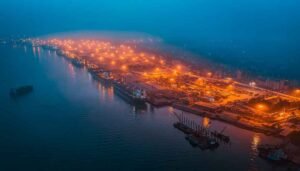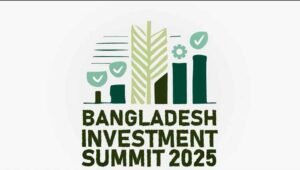Bangladesh Army in the era of Bangladesh 2.0 Home /...
Read MoreBest 5 Foreign Investment Opportunities in Bangladesh 2025
Bangladesh has become a preferred destination for foreign investors due to its business-friendly environment, skilled workforce, and supportive government policies.
The opportunity has grown even more since the fall of Hasina—known for mass killings and economic exploitation—on August 5, 2024.
The interim government is making every effort to improve the investment climate. With a clear goal to make Bangladesh the manufacturing hub of South Asia by 2045, the country is steadily moving forward.
Today, we’ll explore the investment opportunities and highlight the top sectors for foreign investment in Bangladesh. And Then briefly review the key initiatives the government has taken to build an investor-friendly environment.
To help foreign investors make informed decisions, here are some of the most promising sectors in Bangladesh:
1. ICT and Software Sector
Currently, the software industry is the fastest-growing sector in Bangladesh. Yet, only a handful of foreign companies have entered this market.
Opportunities:
Over the past decade, the face of Bangladesh’s IT services sector has transformed. Nearly 500,000 freelancers—both from urban and rural areas—are working remotely for international clients.
This presents a valuable opportunity for foreign investors. Compared to Europe and the US, Bangladesh offers a large pool of skilled professionals at significantly lower costs.
Government Support:
Investors in the ICT and software sector will enjoy tax exemptions for the next 10 years and can maintain 100% ownership of their companies.
Market Gap:
There’s still a lack of smart solutions for agriculture and farming in Bangladesh. Additionally, leading local software companies like Brain Station 23 are already creating software in Bangladesh and selling it in European and American markets. This too opens up new opportunities for foreign investors.
2. Ready-Made Garments (RMG)
The ready-made garments sector accounts for 80% of Bangladesh’s total exports. Globally, Bangladesh ranks as the second-largest exporter in this industry.
Opportunities:
With nearly 50 years of experience in garment manufacturing, Bangladesh has a highly skilled workforce. Investors can produce high-quality apparel at competitive costs—making it a profitable venture.
Government Support:
Bangladesh’s economic zones offer special benefits for setting up factories. Investors enjoy 10 years of tax-free operations in these zones and are allowed full (100%) ownership.
Additionally, there are duty exemptions on the import of machinery and raw materials.
Growth Potential:
In the next few years, the RMG sector is projected to surpass USD 60 billion in annual growth.
Market Gap:
There is massive potential in producing eco-friendly garments and branded sportswear—segments that are still underexplored.
3. Pharmaceutical Sector
After garments, pharmaceuticals is Bangladesh’s second-largest export sector. It meets around 98% of domestic demand and exports to over 150 countries worldwide.
Opportunities:
Globally, there’s a growing shift toward lifestyle-related health products. Additionally, there is strong demand for medications related to diabetes, cancer, and heart disease—offering investors a promising space to explore.
Government Support: The government has initiated the establishment of an Active Pharmaceutical Ingredient (API) Park to boost local production.
Market Gap:
There’s a significant lack of local production of raw materials, clinical research facilities, pharma R&D, and biotech products in Bangladesh. In other words, this market remains largely untapped.
Furthermore, there’s a shortage of high-quality hospitals in the country. Recently, China has started investing in this space, with both Bangladesh and China agreeing to build three complexes under the China-Bangladesh Friendship Hospital initiative.
Foreign investors can take advantage of this growing healthcare demand and infrastructure gap.
4. Renewable Energy
Renewable energy has become an essential global priority for two main reasons:
To replace environmentally destructive, unsustainable energy sources
To bring the benefits of modern science and energy access to remote regions
Bangladesh is also moving forward with this vision. The government has set a target to generate 40% of the country’s total energy from renewable sources by 2041.
For foreign investors, this opens up a timely opportunity to tap into a high-growth, future-proof sector.
Growth Potential:
Currently, renewable energy contributes only around 4% of the energy mix (about 900 MW). By 2041, this is projected to rise to 40 GW.
Private and foreign companies will have the opportunity to operate as Independent Power Producers (IPPs), opening up flexible and profitable models of investment.
Market Gaps:
There is a lack of proper irrigation systems in remote agricultural lands. In hilly areas where electricity is unavailable—but agricultural output is high—solar-powered cold storage systems have huge potential.
There is strong demand for durable, home-use solar solutions, which are currently in short supply.
For travelers and adventurers heading into remote areas, portable chargers and solar-powered power banks offer untapped business opportunities.
5. Agro-Based Industries
Over 70% of Bangladesh’s rural economy still depends directly on agriculture, making it the true foundation of the country’s economy.
In many regions—like the north—certain crops grow in abundance (e.g., potatoes), but the benefits of this surplus often don’t reach urban consumers, who end up paying higher prices.
On the other hand, oversupply creates storage and distribution challenges at the local level.
This imbalance creates a major opportunity: Bangladesh can be an ideal destination for foreign investors in agricultural storage, processing, and exports.
Growth Potential:
Agricultural exports from Bangladesh are growing at a steady rate of 10% to 15% annually.
The government has recently taken initiatives to set up Agro-Processing Zones across the country.
There’s a huge international demand for Bangladeshi halal meat, fresh vegetables, and dairy products.
Market Gaps & Opportunities:
Fruit Processing: Bangladesh produces large volumes of mangoes, lychees, jackfruits, and pineapples—yet lacks modern processing facilities.
Cold Chain & Logistics: There’s an urgent need for investment in the storage, transportation, and supply chain of agricultural goods.
Agri-Tech Solutions: Smart technologies for climate analysis, crop monitoring, and precision irrigation are still underdeveloped—opening doors for foreign agri-tech firms.
Government Initiatives to Create an Investor-Friendly Environment
Political Commitment:
The government has secured a commitment from all major political parties to maintain a stable and supportive investment climate—regardless of who comes to power in the future.Direct Dialogue:
During investment summits, foreign investors have had the opportunity to engage directly with political parties to discuss long-term business prospects.One-Stop Service:
To simplify starting a new business, the government is streamlining all paperwork and licensing processes through a single service desk.Energy Security:
To ensure long-term energy security for industries, the government is signing long-term agreements with multiple countries for stable energy supply.Economic Zones Activation:
Special economic zones are being fully activated with all necessary facilities to support the smooth establishment of factories and manufacturing units.
Government Promotes China Investment In Bangladesh 2.0
Home / Government Promotes China Investment In Bangladesh 2.0 ...
Read MoreMatarbari & Chittagong Port will make Bangladesh Next Singapore
Home / Matarbari and Chittagong Port Establish Bangladesh as the...
Read MoreInvestment Summit 2025: Ushering in a New Era in Bangladesh 2.0
Home / Investment Summit 2025: Ushering in a New Era...
Read More


